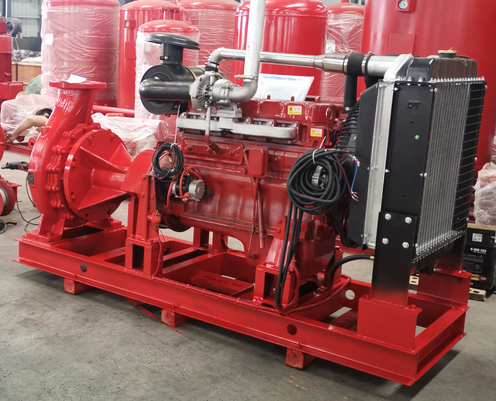Working principle of diesel fire pump
The working principle of the diesel engine fire pump mainly involves key links such as power conversion, water extraction, pressurization and transportation. The following is a detailed explanation of the working principle:
1. Power conversion
Power source: The diesel engine fire pump uses the diesel engine as the power source, and converts the heat energy generated by diesel combustion into mechanical energy to drive the pump body to work. This power mode enables the diesel engine fire pump to work normally in the case of power outage or instability, improving the reliability of the fire protection system.
2. Water extraction and pressurization
Water absorption process:
Through the suction pipe, the diesel engine fire pump sucks external water or other fire extinguishing agents into the pump body. In this process, due to the certain negative pressure between the suction pipe and the pump cavity of the pump, the water is smoothly sucked into the pump cavity.
When the water enters the pump cavity, as the impeller rotates, the water is thrown to the edge of the impeller. Under the action of centrifugal force, the water is transported to the outlet of the pump along the channel in the pump cavity, completing the initial pressurization process.
Pressure process:
While the impeller throws water, a low-pressure area will be formed at the center of the impeller. Since the pressure in the pump chamber is lower than the atmospheric pressure, the atmospheric pressure will push the water to the center of the impeller, thereby further increasing the water pressure.
As the impeller continues to rotate, the water pressure continues to rise, and finally reaches the required pressure value, ready to be delivered to the fire protection system.
3. Delivery process
Water delivery process: High-pressure water is delivered to the fire scene through the outlet pipe for fire extinguishing. During the delivery process, although the pressure in the outlet pipe will be reduced due to the flow of water, since the pressure in the pump chamber is always higher than the pressure in the outlet pipe, the water can continue to flow to the outlet pipe steadily to ensure that the fire scene is adequately supplied with water.
4. Features and advantages
Independence: It does not rely on power supply, which improves the reliability of the fire protection system.
High flow and high head: It can meet the water supply needs of large fire scenes.
Durability: The diesel engine is designed to be durable and reliable, and can operate for a long time in harsh environments.
Simple maintenance: Although regular inspection and maintenance are required, the overall maintenance is relatively simple.
Automatic start: Modern diesel engine fire pumps are equipped with an automatic start system that can quickly start the pump body when a fire occurs, improving the response speed.

In summary, the diesel engine fire pump, through its unique power conversion mechanism and water extraction, pressurization and delivery process, can provide a stable and reliable water source support for the fire protection system in an emergency.




